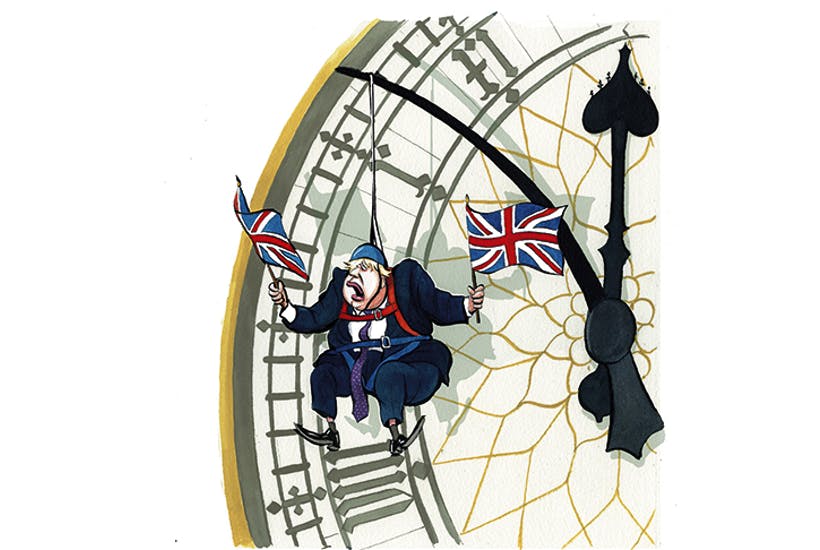In my old job as an investment banker, there were two schools of thought about how to get the best return. Long-term funds – where money was invested over a number of years; and short-term ones – which sought quick returns wherever it could be found. The Conservative party now finds itself facing a similar dilemma: wondering whether to make the short term bet – aping the Brexit Party’s push for no deal in the hope of an immediate recovery from its dire position. Or whether to take the long view: make for the centre ground while still delivering Brexit. The latter is a strategy that is riskier in the medium term but could represent better long-term success. So what should the Tories do? And is Boris Johnson really the man to turn around the party’s ailing fortunes?
How to win?
If the Conservatives and Labour are in first and second place respectively (a challengeable assumption given the state of the polls, particularly recent numbers out from Lord Ashcroft) the next Tory leader only needs to have an approval rating 10-15 per cent points higher than Corbyn for a majority Tory Government to be returned.
The extraordinarily-strong relationship between leader ratings and what happens at a general election has not changed (when all else has) in the past four years. This is now almost the last cast iron rule of politics that has not shifted, even in the age of Trump and Brexit.

Relationship between leader ratings and general election outcome
The bad news for Corbyn
For Labour, this makes grim reading. Why? Because Corbyn has upended typical opposition leader performance, given the position in the electoral cycle we’re in.
The trends for the last 35 years are for opposition leader ratings to increase while their party is out of power. This continues until their party takes over, when their approval rating usually dips.
But Corbyn’s poor ratings today buck that trend. And while Theresa May also has dismal approval ratings, that is to be expected. What’s more, with a change in leadership on the cards for the Conservatives, the party now has a chance to renew itself in the eyes of voters.
So while it is tumultuous in the Tory party at the moment, the leadership contest presents a moment of real vulnerability for Labour. With Corbyn’s personal ratings of 19 per cent, the next Tory leader need only have 30-40 per cent of the electorate “approve” of their job performance to return, in all likelihood, a majority government. This means that a Tory Kinnock could win the next election – even if that feels a long way off with the polls as they are.
What the Tories must decide
The question for Tories then is this: who can win firm support from a coalition of voters that will make up at least a third of the electorate (Corbyn’s 19 per cent rating + 10-15 per cent winning gap)?
The polls would suggest that under a Trump-like government, Boris Johnson is the best pick. Most recent numbers for him indicate personal support just below this necessary threshold of 30-35 per cent personal approval ratings.
Johnson is, in all probability, best placed among his fellow candidates to encourage 2017 Tory voters who defected to the Brexit Party to come back. Given that the Brexit Party is now polling at roughly equal pegging with the Tories – and following a devastating set of European elections – the need to match or merge with the Brexit Party is the smart strategy in the short term.

What British voters think of Boris Johnson
The good – and bad – news about Boris
So there is good evidence that, in the short-term, Johnson could make a fist of battling Corbyn and winning the keys to No 10. But there is a drawback. Unless Johnson can find a way to tackle areas where his electoral appeal is less strong, then, in the long term, the Tories could pay a price and a Johnson government could fundamentally speed up the changes occurring to the demographic base of the Conservative coalition.
This “Boris” effect was first made clear in his second successful run at the London mayoralty in 2012. Johnson has strong appeal among white voters who identify as English. C2 voters, Leave voters, those without formal qualifications and those of mid affluence from less-urban areas are also likely to back the Tories under Boris.
In the 2012 mayoral election, Johnson won over such voters while retaining the support of other Tory voters; his candidacy added additional votes to the anaemic London Assembly Tory share. Johnson 1.0 was electoral gold.

The ‘Boris’ effect in London 2012
Even today, a Johnson-led Tory party could stop Corbyn. That should not be lightly dismissed.
Yet while Boris could deliver a short-term win there could be longer-term costs. The demographic groups most likely to be repelled by a Johnson candidacy are the parts of Britain that are growing fastest. These are also the bits of Britain of particular strategic importance to the Tories, given that the party are the only expressly UK-wide Unionist party.
If the Conservative party stands alone for the Union, a Johnson administration will have its work cut out to stop English Nationalism from becoming a defining feature of its politics. He will have to find a way of accommodating and working with Ruth Davidson’s Scottish Conservatives. He may even have the opportunity to restructure and recalibrate English nationalism into something more positive. But can he meet this challenge?
The Conservatives now barely hold a seat where the BAME population is above 30 per cent, so the party simply cannot afford in the long term to become any more toxic with BAME voters. Johnson could potentially exacerbate this problem. Even back in 2012, the strongest predictor of Johnson not winning extra votes versus the Conservative assembly vote was the percentage of BAME voters in each ward.
Today’s Johnson 2.0 is still markedly more popular among voters who won him the mayoralty, but probably less popular among professionals, younger voters, BAME voters and urban voters than his party as a whole. Johnson is also less popular among these groups when compared to other Tory leadership candidates. Donald Trump lending Johnson his support is unlikely to help much.

The downside to Boris
It is a similar story among university graduates – a rapidly expanding proportion of the electorate. More and more city seats are falling away from the Conservatives as graduates learn, earn, and move out into the suburbs.
Britain is increasingly dividing along lines of age, ethnicity, and education – more than it is wealth. A Johnson premiership might speed up this process, redrawing the electoral map and re-anchoring the Conservative party demographically, politically and philosophically towards older, more rural voters. The Tories would gain ground in market towns and lose ground in bigger cities, and among professionals.
Many Conservative commentators seem delighted that the Conservatives are abandoning the cities and those with degrees. But they are wrong to celebrate. It takes a special type of logic for the Conservatives to be the party of wealth and the upper class throughout the twentieth century, when most people were identifiably working class, only to abandon the middle class and professionals precisely at the moment that they are set to become the biggest voting group in Britain.
Could the Tories turn into a version of the US Republicans?
The Liberal Democrats are beginning to draw level with the Brexit Party in the polls. And those goading the Conservative party to become a watered-down version of the Brexit Party are often guilty of deploying Morton’s Fork. In doing so, they argue that if the party doesn’t have hard Brexit votes it should shift to the right to gain them, and if it does have the hard Brexit votes it should continue to cultivate them.
As a result of this thinking, a rotation is occurring that could transform the Conservative party into something far more akin to the Republican party in the States. Already some of the ERG-tested candidates have renounced feminism and LGBT rights. I wonder if climate change is next in their sights?
The Brexit process is engendering change on the right which is hugely transformative and politically discombobulating. The question is: is this inevitable? And can it be stopped?

Education versus age in England and Wales
The people yearning for a Johnson premiership have got the first part of their diagnosis correct: a traditional Conservative seeking a fourth term amidst this chaos simply won’t do.
Instead, the next leader will need a clear blueprint and a distinct appeal in order to hit the ‘reset’ button on the clock of Tory incumbency. The party is currently too unpopular to do anything other than opt for change.

Net satisfaction with the government, 1979 – 2019
Public attitudes towards austerity have got colder. Voters think the Brexit negotiations have been a disaster. And large seam of traditional Conservative voters now have a revitalised Liberal Democrats to tempt them from the left and the Brexit party on the right. In such circumstances, Johnson is not the only change candidate who presents a viable path to victory.
Time for ‘The Saj’?
But there is a longer-term bet which the Conservatives could make. There are areas of the electoral map that remain unexplored for the Conservatives: large parts of the public sector, social renters, BAME voters. This is not Remain land we are talking about. It is Labour land.
Rory Stewart, Matt Hancock and Sajid Javid collectively form a group of leaders who could delve deep into Labour and Liberal Democrat country, offering an alternative path to power which would be different to the short term bet of Johnson.
All are committed to Brexit, so we are really talking about their positioning on issues other than the EU. To date much of the available polling evidence of the UK population and Conservative voters suggests that, of the three, Javid has the lowest negatives of all the candidates. This is not a quirk; it clearly suggests Javid offers something different.

How the Tory leadership candidates fare
But is he the candidate to bear Labour? Last month’s local elections and European election offer good insight into what makes people vote Labour and also who is best positioned to tempt such people into backing the Tories. So who are the groups most inclined to vote for the Labour party and which Tory candidates can meet these voters’ needs and convince them the party is on their side?

Despite the shifts in Labour’s structural vote over the last decade, at its core are lower income voters, BAME voters and voters likely to have a deep relationship with the state by dint of family composition, lack of income and the need for welfare. This is a world that is almost entirely alien to most Conservative MPs and leadership candidates.

Who votes Labour?
The chart above indicates that Labour’s core vote is still those least well off, most likely to rent from their local authority, take public transport and claim welfare.
A Tory leadership contender who actually understands this life could be a game changer. Repeated analysis and polling – particularly that carried out over the past ten years by Lord Ashcroft – indicates that the major driver behind people not voting Tory is that they are considered a party for the rich, and not on the side of people like me.
There’s a scenario in which Javid could convincingly take on these two massive roadblocks to voting Tory. The Javid path towards an election winning 30-40 per cent personal approval rating is less clear than Johnson’s as things stand. But in the long term, it is a path which may future proof the party among BAME voters and professionals.
Javid (along with Hancock and Stewart) could move into Labour territory and create a different Conservative coalition – one more fit for the future and able to hit Corbyn at his base.
What happens if Corbyn goes?
There is also the issue of what happens if Corbyn is replaced as Labour leader by a more moderate candidate who doesn’t drink so deeply from the well of Marxism, anti-western foreign policy and fringe politics. If this happens, the Conservative party may be gearing up for the wrong fight. Johnson is well positioned to take on 70-year old Corbyn. But what if Corbyn goes to be replaced by someone who isn’t so keen to requisition wealth and wear shabby clothes?
The Conservative membership and MPs are haunted by the spectre of Corbyn and daily polls that show the party in free-fall by dint of the Brexit Party and the Liberal Democrats. In this environment it is hard to think long-term; that’s entirely rational and fair. But it is worth asking: is Boris Johnson really the only way for the Tories?
James Kanagasooriam helped run the data strategy for the Scottish Conservatives 2015-17 and was head of analytics at Populus 2014-2018. He now sits on the board of centre-right think tank Onward and is a management consultant at OC&C







Comments